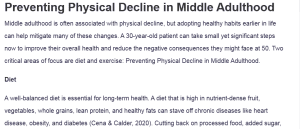Preventing Physical Decline in Middle Adulthood
Middle adulthood is often associated with physical decline, but adopting healthy habits earlier in life can help mitigate many of these changes. A 30-year-old patient can take small yet significant steps now to improve their overall health and reduce the negative consequences they might face at 50. Two critical areas of focus are diet and exercise: Preventing Physical Decline in Middle Adulthood.
Diet
A well-balanced diet is essential for long-term health. A diet that is high in nutrient-dense fruit, vegetables, whole grains, lean protein, and healthy fats can stave off chronic diseases like heart disease, obesity, and diabetes (Cena & Calder, 2020). Cutting back on processed food, added sugar, and unhealthy fats also benefits metabolic function and keeps weight in a healthy ratio.
Getting enough calcium and vitamin D also benefits bone density, staving off osteoporosis in later years. Hydration is also vital, as adequate water intake aids digestion, circulation, and overall cell functioning. Limiting excessive caffeine and alcohol intake can also ensure stable energy levels, avoid dehydration, and minimize the risk of chronic diseases such as hypertension.
Exercise
Regular physical activity is another crucial factor in preventing physical decline. Participation in at least 75 minutes of vigorous-intensity or 150 minutes of moderate-intensity aerobic activity every week can have the benefits of boosting cardiovascular functioning, the muscles as well as the metabolic rate (Daniels et al., 2023). Moderate strength training two to three times a week will assist in preventing loss of muscle mass and bone density, features that deteriorate with age.
Further, the flexibility and balance arising from such practices as yoga can help to minimize future falls and enhance general motility in elderly persons. Regular exercise integrates physical activity into life and can improve the quality of life, lifespan, and physical fitness. Exercise also helps in easing stress and improving sleep, which are important for maintaining the health of a person over the years.
By making conscious choices about diet and exercise in early adulthood, individuals can significantly improve their long-term health outcomes and maintain a higher quality of life as they transition into middle adulthood.
References
Cena, H., & Calder, P. C. (2020). Defining a healthy diet: Evidence for the role of contemporary dietary patterns in health and disease. Nutrients, 12(2), 1–15. https://doi.org/10.3390/nu12020334
Daniels, K., Lemmens, R., Knippenberg, E., Marinus, N., Vonck, S., Baerts, J., Bergs, J., Spooren, A., Hansen, D., & Bonnechère, B. (2023). Promoting physical activity and a healthy active lifestyle in community-dwelling older adults: A design thinking approach for the development of a mobile health application. Frontiers in Public Health, 11(47), 1280941. https://doi.org/10.3389/fpubh.2023.1280941
ORDER A PLAGIARISM-FREE PAPER HERE
We’ll write everything from scratch
Question 
Required Resources
Read/review the following resources for this activity:
- Lally, M., & Valentine-French, S. (2019). Lifespan development: A psychological perspectiveLinks to an external site. (2nd ed.). Open Textbook Library. https://open.umn.edu/
opentextbooks/textbooks/ lifespan-development-a- psychological-perspective - Chapter 8: Middle Adulthood
- edapt concepts
- Minimum of 1 scholarly source (in addition to the edapt and ebook resources listed above)
Initial Post Instructions
Option 1: In your readings this week, there is an extensive discussion on the physical decline that adults in their middle adulthood may likely face. What are some small steps that a 30-year-old patient can take now that can help reduce some of the negative physical consequences that they could experience at 50 years old?

Preventing Physical Decline in Middle Adulthood
Address at least 2 of the 6 listed:
- Diet
- Exercise
- Substance use, abuse, dependence (caffeine, nicotine, THC, etc.)
- Stress
- Sleep
- Sexual behaviors
